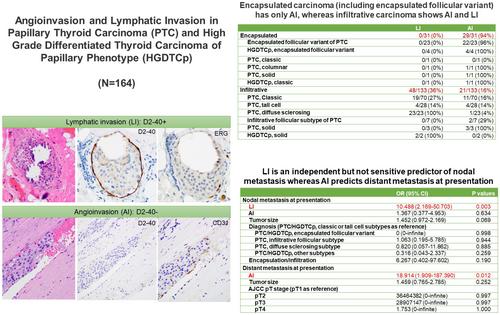Defining angioinvasion and lymphatic invasion in papillary thyroid carcinoma: morphological criteria, utility of D2-40/CD31/ERG immunohistochemistry and correlation with clinicopathological characteristics
Abstract
Aims
While CAP and ICCR protocols mandate the separation of angioinvasion (AI) and lymphatic invasion (LI) in thyroid carcinoma, distinction between them can be difficult. Because the presence of AI is used to stratify patients with papillary thyroid carcinoma (PTC), there is a need to accurately diagnose AI and LI.
Methods and results
AI and LI were evaluated in 162 cases of PTC (n = 155) and high-grade differentiated thyroid carcinoma, papillary phenotype (HGDTCp, n = seven) using haematoxylin and eosin (H&E), D2-40 and CD31/ERG. In encapsulated carcinomas, vascular invasion (VI) was only of AI nature. Infiltrative carcinomas showed LI (46 of 131, 35%) and AI (19 of 131, 16%). The frequency of nodal metastasis (NM) and large volume of NM was 93 and 85%, respectively, in tumours with LI, and 39 and 26%, respectively, in those without LI. Luminal red blood cells and smooth muscle in the wall of large-calibre vessels were not reliable criteria to exclude LI and were seen in 23 and 6% of LI, respectively. LI was an independent predictor for NM, whereas AI is an independent predictor for distant metastasis at presentation in PTC/HGDTCp.
Conclusion
VI in encapsulated carcinomas, including follicular variant PTC, is only of AI nature, confirming the position of this variant as a close entity to follicular carcinoma rather than classic PTC, whereas infiltrative PTC/HGDTCp may have LI or, less frequently, AI. As no morphological features reliably distinguish LI from AI, D2-40 and CD31/ERG immunostains should be considered for separating AI from LI when dealing with vascular invasion in an infiltrative PTC.


 求助内容:
求助内容: 应助结果提醒方式:
应助结果提醒方式:


